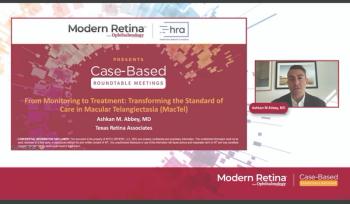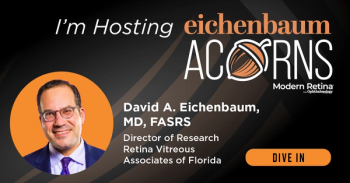
- Modern Retina Winter 2024
- Volume 4
- Issue 4
Advancements in ocular drug delivery
Options empower patients and providers to decrease treatment burden
Although intravitreal injections are a safe and effective form of drug delivery, the need for frequent injections and the corresponding disruptions to patients’ lives can pose a significant treatment burden for patients. Patients may miss injection visits due to trouble taking time off work or finding someone to bring them to the clinic or due to illness, as many patients with chronic retinal diseases are older and therefore may be more likely to have comorbid conditions.1 As such, the promising results observed in clinical trials of drugs for chronic retinal diseases that require intravitreal injections are often not replicated in real-world conditions due to lack of adherence.2 When these patients miss doses, they may also be losing vision that they cannot recover, so finding ways to improve treatment durability is paramount to enhancing care. Recent innovations in drug delivery platforms, such as gene therapy, the port delivery system (PDS), and the encapsulated cell therapy (ECT) platform, offer the potential to address these issues by offering continuous delivery of medications for chronic diseases that can increase treatment durability and reduce patient burden to enhance adherence.
Gene therapy
One approach that is being actively investigated to address the problem of drug durability has been gene therapy using adeno-associated vectors (AAVs) as a drug delivery device. The AAV delivers DNA into patient cells and turns them into biofactories, which then code for and produce specific proteins such as aflibercept or ranibizumab to treat diseases such as age-related macular degeneration (AMD) or diabetic macular edema (DME). These therapies may result in a single treatment for some patients, but others may require supplementary intravitreal injections from time to time.
Gene therapies using AAVs have shown promise in findings from preclinical and phase 1 and 2 clinical trials and are currently being investigated in several phase 3 trials for a variety of retinal conditions.3 Intraocular inflammation as well as iris and retinal pigmentary changes can occur following AAV-based gene therapy, but in most cases, the inflammation can be controlled with topical steroids; however, more severe cases of inflammation and hypotony have been reported.4 Although long-term safety studies are underway, the relative novelty of these therapies precludes us from knowing the entirety of their long-term effects, especially 20 or 30 years down the road, and as such, some caution may be warranted. However, the engineering of more effective viral and nonviral vectors to efficiently and safely transduce ocular cells in the future could solve many of these issues, and I look forward to future developments in gene therapy.
Port delivery system
The PDS (Susvimo; Genentech Inc) is a surgically implanted, in-office refillable device that provides continuous drug delivery of ranibizumab for up to 6 months to patients. The PDS is US Food and Drug Administration (FDA) approved for the treatment of neovascular AMD5 but is also being investigated for other chronic retinal diseases, such as DME and diabetic retinopathy. Although the PDS faced a voluntary recall in October 2022 due to cases of septum dislodgment,6 it has since returned to the market following modifications, such as doubling of the bonding strength of the septum component and added lubrication on the refill needle, which has also made it easier to refill when patients return to the clinic.7 In my experience, the PDS has offered a subset of my patients the opportunity for lessened treatment burden, and we have had patients in our practice who have successfully used it for more than 7 years and prefer it to the regimen of frequent intravitreal injections.
There are some headwinds that may hinder the uptake of the PDS; the implantation surgery needs to be very meticulous and requires preoperative training, and the increasing durability of some of the newer anti-VEGF agents limits the need for the PDS. There is also a risk of endophthalmitis
associated with this device, for which the FDA instituted a black box warning, which has affected its use. However, it has the potential to be a flexible technology. It will be interesting to see whether future iterations that can deliver other drugs become available, as the PDS is a platform therapy.
Encapsulated cell therapy
The ECT platform (Neurotech Pharmaceuticals, Inc) currently in development and not yet approved by the FDA represents an interesting intersection of gene therapy and a drug delivery device such as the PDS; in the ECT platform, genetically altered cells, such as retinal pigment epithelial cells, are encased in a semipermeable capsule, which is then implanted to continuously produce therapeutic proteins, such as ciliary neurotrophic factor. Unlike gene therapy, which permanently alters retinal cells, the ECT does not alter retinal cells and thus can be removed or replaced.
The ECT platform is currently being investigated as a treatment for macular telangiectasia (MacTel) type 2, which is a condition that does not currently have an available treatment, and it has demonstrated efficacy in findings from 2 phase 3 clinical trials.8 Findings from multiyear safety studies with the ECT platform have also demonstrated that it is well tolerated, with most treatment-emergent adverse events being mild and transient and a low rate of devices being removed from patients.9
Despite these promising results, it is important to note that any surgery comes with risks of infection and retinal detachment, although these are uncommon. As the ECT is customizable, it may be used in the future for sustained delivery of different targeted proteins, and as such, it may hold promise for treating a variety of conditions. Neurotech Pharmaceuticals publicly announced in June 2024 that the FDA has granted priority review for the company’s biological license application for the use of the ECT platform in MacTel with a Prescription Drug User Fee Act date in December 2024.
Conclusions
There are currently a variety of innovative drug delivery technologies that are being developed for chronic retinal diseases, and as eye care providers, we should not limit the tools we can access in our armamentarium. It is advantageous for both our practices and our patients to take full advantage of these resources and to keep ourselves up to date with the latest research so we can customize the care we deliver for our patients. There are a wide variety of resources available for education on these new systems, and the companies behind them are rolling out surgical training courses. Approaching any new therapy with caution and skepticism is advisable, but we are living in an exciting time, and I look forward to seeing how future developments in ocular drug delivery can help us improve the quality of life for our patients with chronic retinal disease. •
References
1. Umfress AC, Brantley MA Jr. Eye care disparities and health-related consequences in elderly patients with age-related eye disease. Semin Ophthalmol. 2016;31(4):432-438. doi:10.3109/08820538.2016.1154171
2. Ham Y, Mehta H, Kang-Mieler J, Mieler WF, Chang A. Novel drug delivery methods and approaches for the treatment of retinal diseases. Asia Pac J Ophthalmol (Phila). 2023;12(4):402-413. doi:10.1097/APO.0000000000000623
3. Cheng SY, Punzo C. Update on viral gene therapy clinical trials for retinal diseases. Hum Gene Ther. 2022;33(17-18):865-878. doi:10.1089/hum.2022.159
4. Chan YK, Dick AD, Hall SM, Langmann T, Scribner CL, Mansfield BC; Ocular Gene Therapy Inflammation Working Group. Inflammation in viral vector-mediated ocular gene therapy: a review and report from a workshop hosted by the Foundation Fighting Blindness, 9/2020. Transl Vis Sci Technol. 2021;10(4):3. doi:10.1167/tvst.10.4.3
5. Susvimo. Genentech Inc. Accessed September 7, 2024. https://www.gene.com/download/pdf/susvimo_prescribing.pdf
6. Sharma A, Khanani AM, Parachuri N, Kumar N, Bandello F,
Kuppermann BD. Port delivery system with ranibizumab (Susvimo) recall- what does it mean to the retina specialists. Int J Retina Vitreous. 2023;9(1):6. doi:10.1186/s40942-023-00446-z
7. Susvimo implant to return to market following recall. Review of Ophthalmology. August 10, 2024. Accessed September 9, 2024. https://www.reviewofophthalmology.com/article/susvimo-implant-to-return-to-market-following-recall
8. Kaiser Maharjan E. FDA grants priority review to novel treatment for macular telangiectasia type 2. Optometry Times. June 20, 2024. Accessed September 9, 2024. https://www.optometrytimes.com/view/fda-grants-priority-review-to-novel-treatment-for-macular-telangiectasia-type-2
9. Egan C, Bernstein P. Pooled clinical trial safety data of neurotrophic factor-producing revakinagene taroretcel in people with macular telangiectasia type 2. Paper presented at: 24th Euretina Congress; September 19-22, 2024; Barcelona, Spain.
Dante Pieramici, MD
E: dpieramici@yahoo.com
Pieramici is a retinal specialist, surgeon, and partner at California Retina Consultants, where he has practiced for 24 years. Pieramici has a long history of clinical research aimed at better understanding the underlying pathophysiology of ocular diseases. He has published more than 160 peer-reviewed articles and 16 book chapters and has edited 3 books on retinal diseases.
Disclosure: Pieramici is a consultant for Neurotech Pharmaceuticals, Inc.
Articles in this issue
about 1 year ago
Excellence across the board at the 2024 Euretina Congressabout 1 year ago
A-memia? Anecdotal evidence in the era of memesabout 1 year ago
Ocular nerve regrowth following use of diabetes drugabout 1 year ago
The deep dish on all things ophthalmology at AAO 2024about 1 year ago
A field guide to optic disc drusenNewsletter
Keep your retina practice on the forefront—subscribe for expert analysis and emerging trends in retinal disease management.












































